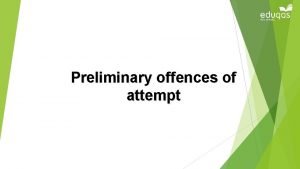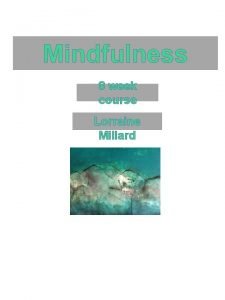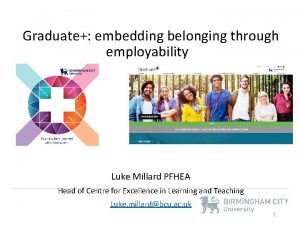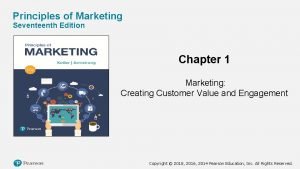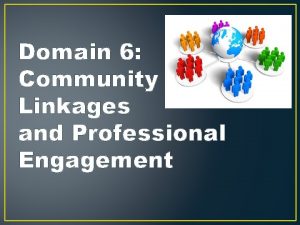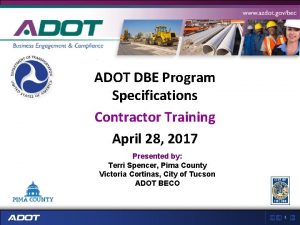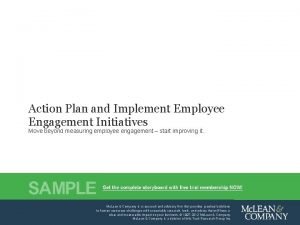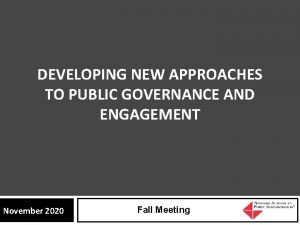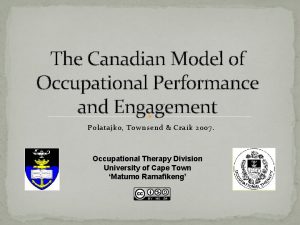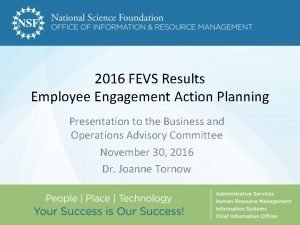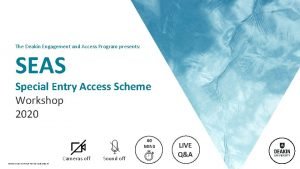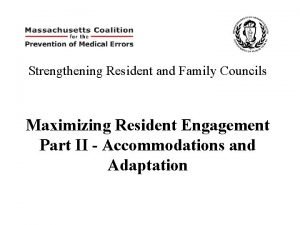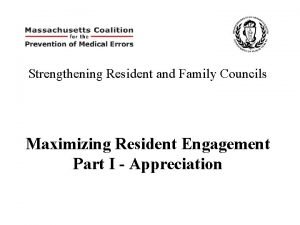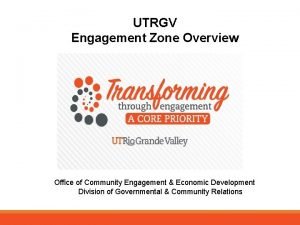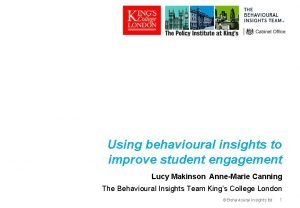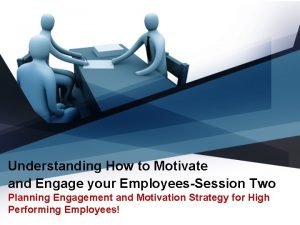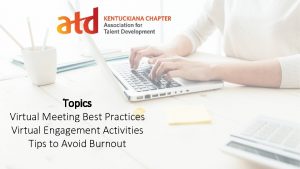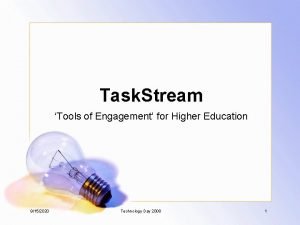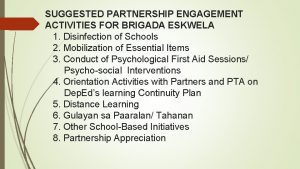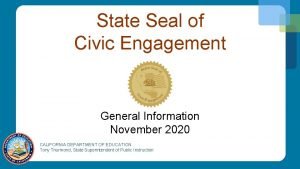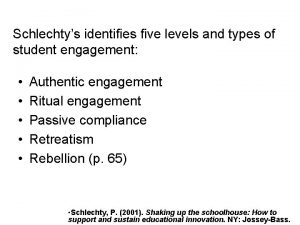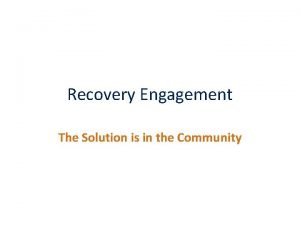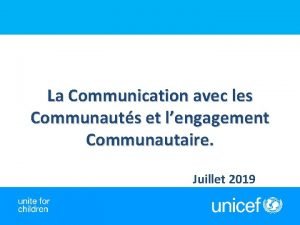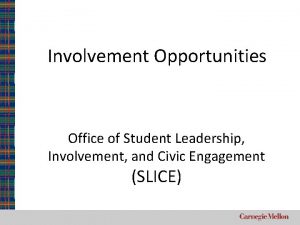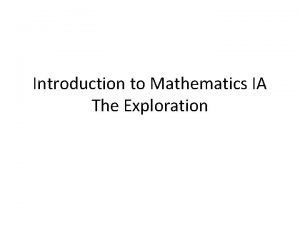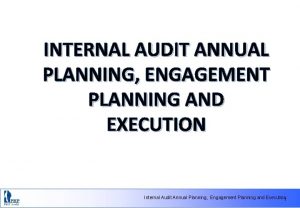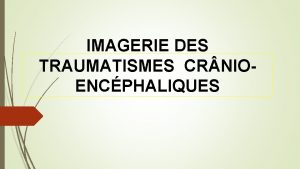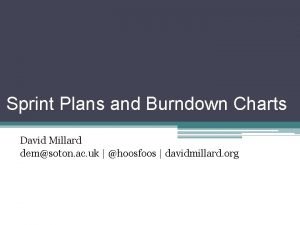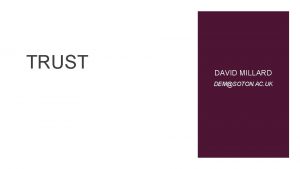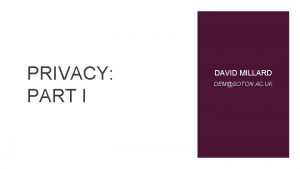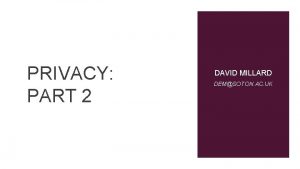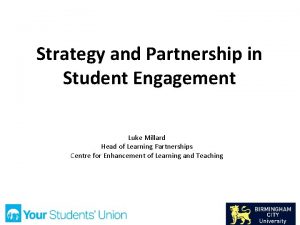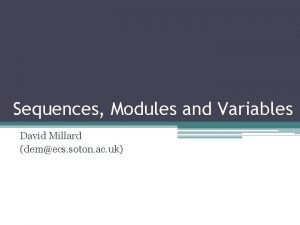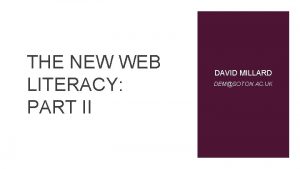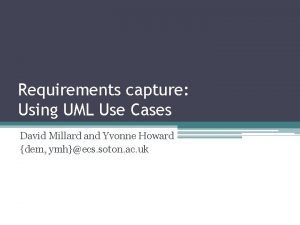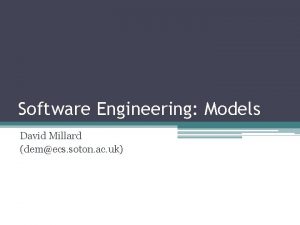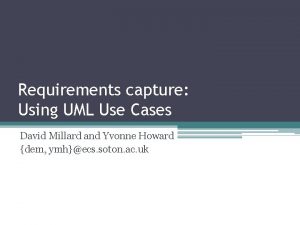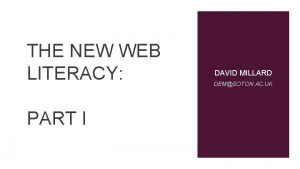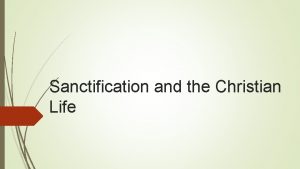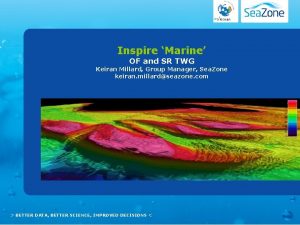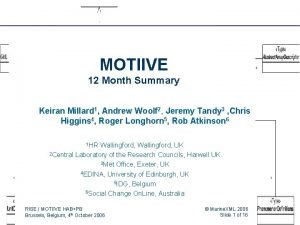Envisioning and Engagement David Millard demsoton ac uk


































- Slides: 34

Envisioning and Engagement David Millard dem@soton. ac. uk | @hoosfoos | davidmillard. org

Envisioning and engagement • SSM as part of a Software Engineering ▫ Stakeholder Analysis ▫ Storyboarding • Information gathering techniques ▫ Interviews, Focus Groups, and Research Questions • Ethics of engagement

The Big Software Engineering Picture

Software Engineering: Big Picture Requirements Gathering • Surveys • Stakeholder Analysis • Focus groups • SSM Specification • UML • Use Cases • Scenarios and Personas • Storyboards Design • UML • Class Diagrams • Activity Diagrams • Sequence Diagrams • Etc… Implementation • Software code • APIs • Document formats Testing • Unit Tests • Black Box Tests • Etc… Deployment • Configuration • Bug Tracking • User Support This is rarely a straightforward progression – in reality there are lots of iterations and points of feedback

Software Engineering: Big Picture Requirements Gathering • Surveys • Stakeholder Analysis • Focus groups • SSM Specification • UML • Use Cases • Scenarios and Personas • Storyboards From a problem statement to starting to find a solution – Requirements Capture Design • UML • Class Diagrams • Activity Diagrams • Sequence Diagrams • Etc… Implementation • Software code • APIs • Document formats Testing • Unit Tests • Black Box Tests • Etc… Deployment • Configuration • Bug Tracking • User Support This is rarely a straightforward progression – in reality there are lots of iterations and points of feedback

Requirements Gathering • Surveys • Stakeholder Analysis • Focus groups • SSM Specification • UML • Use Cases • Scenarios and Personas • Storyboards Requirements Capture: What is the Challenge?

Requirements Gathering • Surveys • Stakeholder Analysis • Focus groups • SSM • • • Specification • UML • Use Cases • Scenarios and Personas • Storyboards Users don’t always know what they want They often need help to innovate They may have conflicting requirements They may not have a complete picture They use the language of their mini-world (domain) ▫ Not necessarily the same language as technologists ▫ It may be imprecise and contextual

Requirements Gathering • Surveys • Stakeholder Analysis • Focus groups • SSM • We have already seen: ▫ Soft Systems Models ▫ Scenarios and Personas • Next we will look at: ▫ Stakeholder Analysis ▫ Storyboards Specification • UML • Use Cases • Scenarios and Personas • Storyboards

Stakeholder Analysis

Stakeholder Analysis: Who are the users? • Primary Stakeholders ▫ People who actually use the system Primary

Stakeholder Analysis: Who are the users? • Primary Stakeholders ▫ People who actually use the system • Secondary Stakeholders ▫ People who do not directly interact with the system, but provide input to it, or receive output from it Primary Secondary

Stakeholder Analysis: Who are the users? • Primary Stakeholders ▫ People who actually use the system • Secondary Stakeholders ▫ People who do not directly interact with the system, but provide input to it, or receive output from it • Tertiary stakeholders Primary ▫ People who do not directly interact with the system, but are affected by it Secondary Tertiary

Stakeholder Analysis: Who are the users? • Primary Stakeholders ▫ People who actually use the system • Secondary Stakeholders ▫ People who do not directly interact with the system, but provide input to it, or receive output from it • Tertiary stakeholders Primary ▫ People who do not directly interact with the system, but are affected by it • Facilitating ▫ People who are involved in the design, development and maintenance of the system Secondary Tertiary

Activity: Stakeholder Analysis example Who are the stakeholders for the checkout system of a large supermarket? ▫ ▫ Identify possible primary, secondary and tertiary stakeholders. What are their roles? Stakeholder type Stakeholder Role/description

Storyboards • A visual guide to how software will look and feel ▫ Can be sketches, digital sketches (wireframes), or prototypes (i. e real interfaces but with no functionality) • Help communicate: ▫ spatial layout and structure ▫ workflow through an application ▫ availability or non-availability of functionality at different points

Storyboard: May start as a literal sketch

Evolves into a digital mockup (wireframe)

And finally into a prototype (or interactive mock-up)

Gathering Information

Where do you get your evidence? SSM Stakeholder Analysis Personas and Scenarios (and eventually your UML Diagrams) • All require primary evidence from the business • What are the techniques you can use to get that evidence?

A Successful Information Gathering Campaign • Who will provide you with information? ▫ Identify participants from your stakeholder analysis • What information gathering techniques will give you the information you need? ▫ Interview ▫ Focus group ▫ Questionnaires • Triangulation ▫ Using more than one method to make sure that you gain data from different perspectives - do the results agree?

Interviews Structured Semi-Structured Unstructured • Ask all participants the same predetermined questions • Features of both structured and unstructured interviews • Exploratory conversations around a topic • The questions need to be short and clearly worded • Typically closed questions Closed : Is Wordpress a good website tool? • Closed and open questions • The interviewer has a script for guidance so that all topics are covered with each interviewee • Open ended questions • But the interviewer needs to steer the conversation to ensure that the goal of the interview is met Open : What are the pros and cons of using Wordpress?

Interview Questions • Structured (closed) ▫ Do you consider lectures an important part of your University learning? Photo by College. Degrees 360 via Flickr. com We are interviewing a student and what to get information on their world view around lectures

Interview Questions • Structured (closed) ▫ Do you consider lectures an important part of your University learning? • Unstructured (open) ▫ What are the most important ways in which you learn at University? Photo by College. Degrees 360 via Flickr. com We are interviewing a student and what to get information on their world view around lectures

Interview Questions • Structured (closed) ▫ Do you consider lectures an important part of your University learning? • Unstructured (open) ▫ What are the most important ways in which you learn at University? • Semi-structured (mediated) Photo by College. Degrees 360 via Flickr. com We are interviewing a student and what to get information on their world view around lectures ▫ What are the most important ways in which you learn at University?

Interview Questions • Structured (closed) ▫ Do you consider lectures an important part of your University learning? • Unstructured (open) ▫ What are the most important ways in which you learn at University? • Semi-structured (mediated) Photo by College. Degrees 360 via Flickr. com We are interviewing a student and what to get information on their world view around lectures ▫ What are the most important ways in which you learn at University? � What about lectures? � Is that true for all subjects?

Focus Groups • Interviewing groups of people together ▫ 3 to 10 members of a focus group are typical ▫ Can help to identify conflicts of terminology, expectations or lack of a shared understanding ▫ Can allow diverse or sensitive issues to be raised ▫ Enables people to put forward their opinions in a supportive environment ▫ The interviewer (facilitator) guides and prompts discussion and encourages quieter people to contribute ▫ The facilitator plans a loose agenda to ensure the objectives of the session are covered (like a semi-structured interview)

Activity: Planning information gathering Scenario: You are looking at building a system to manage the information during University Admissions. You have access to the Admissions Tutors, Admin Team and Recent Applicants and want to gather information for your SSM. 1. What methods might be appropriate? 2. What ways could you record the data?

Activity: Planning information gathering Scenario: You are looking at building a system to manage the information during University Admissions. You have access to the Admissions Tutors, Admin Team and Recent Applicants and want to gather information for your SSM. 1. What methods might be appropriate? 2. What ways could you record the data? 3. Assuming you went ahead with a semi-structured interview with the Admissions Tutor – what questions would you ask?

What to Ask? • Use the SSM CATWOE framework ▫ Client, Actors, Transformations, World Views, Owners, Environment • Consider the other elements from SSM ▫ ▫ Scope Inputs and outputs Processes that transform inputs to outputs Resources Authorities and emergent properties

Ensuring Coverage Write research questions Design materials Are all of the research q’s accounted for? Assign a colour to each research question Conduct study Colour code each section of the study materials according to research q’s

Ethics of engagement • • • Before the study During the study After the study Risk of harm Truthfulness/ openness/ communication Protection of data Privacy/ confidentiality Be careful to only ask for what you need Don’t waste time Absolute right to withdraw

Royal Academy of Engineering statement of ethical principles • Accuracy and Rigour • Honesty and Integrity • Respect for Life, Law and the Public Good • Responsible Leadership: Listening and Informing http: //www. raeng. org. uk/news/publications/list/reports/Statement_of_Ethical_Principles. pdf

Summary • SSM as part of a Software Engineering ▫ Stakeholder Analysis ▫ Storyboarding • Information gathering techniques ▫ Interviews, Focus Groups, and Research Questions • Ethics of engagement
 R v millard and vernon
R v millard and vernon Millard reaction
Millard reaction Lorraine millard
Lorraine millard Luke millard
Luke millard Creating customer relationships and value through marketing
Creating customer relationships and value through marketing Ppst domain 6 reflection
Ppst domain 6 reflection Adot - business engagement and compliance (beco)
Adot - business engagement and compliance (beco) Action planning for employee engagement
Action planning for employee engagement Develop new approaches to public governance and engagement
Develop new approaches to public governance and engagement Cmope model
Cmope model Employee engagement survey results and action plan ppt
Employee engagement survey results and action plan ppt Youth engagement and progression framework
Youth engagement and progression framework Seas application example category 4
Seas application example category 4 Resident and family engagement
Resident and family engagement Resident and family engagement
Resident and family engagement Utrgv engagement zone
Utrgv engagement zone Lucy makinson
Lucy makinson Employee engagement programs examples
Employee engagement programs examples Engagement activities for virtual meetings
Engagement activities for virtual meetings Jenny's engagement ring is enormous
Jenny's engagement ring is enormous Taskstream tools of engagement
Taskstream tools of engagement Brigada eskwela plan of activities
Brigada eskwela plan of activities Seal of civic engagement
Seal of civic engagement Iso stakeholder engagement
Iso stakeholder engagement Schlechty's levels of engagement
Schlechty's levels of engagement Recovery engagement center bloomington indiana
Recovery engagement center bloomington indiana Philosophical chairs rules
Philosophical chairs rules Nursing interventions classification (nic)
Nursing interventions classification (nic) Microsoft partner program
Microsoft partner program Engagement communautaire et redevabilité
Engagement communautaire et redevabilité Engagement options
Engagement options Internal assessment
Internal assessment Sample internal audit engagement plan
Sample internal audit engagement plan Academic engagement
Academic engagement Engagement cérébral
Engagement cérébral
